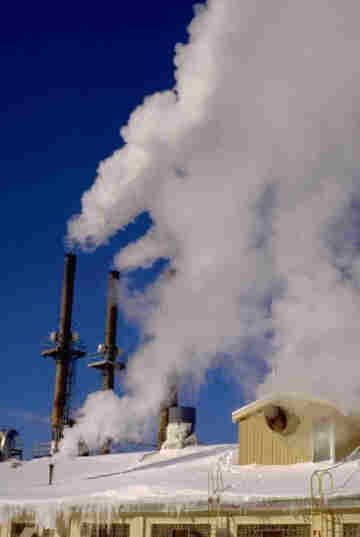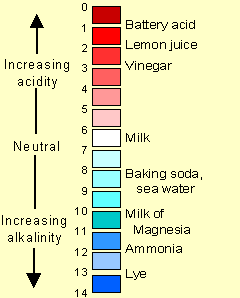|
TEMPERATURE
 Water temperature is an important factor for survival of aquatic life. Very high and very low water
temperature can kill many aquatic plants and animals. The temperature can affect how an
organismís internal mechanisms (metabolism) work. For example salmon and trout prefer
temperatures between (4.5E C) 40E and 20E C (65E F). Different stages of the growth of fish
are susceptible ranges of fish. In the summer when temperatures are high, juvenile fish actively
look for the cooler pools of water. A fish must pump water across its gills to meet its need for
oxygen. If the dissolved oxygen in water is low, the gills must move faster to get enough oxygen
for the fish to survive. Water temperature is an important factor for survival of aquatic life. Very high and very low water
temperature can kill many aquatic plants and animals. The temperature can affect how an
organismís internal mechanisms (metabolism) work. For example salmon and trout prefer
temperatures between (4.5E C) 40E and 20E C (65E F). Different stages of the growth of fish
are susceptible ranges of fish. In the summer when temperatures are high, juvenile fish actively
look for the cooler pools of water. A fish must pump water across its gills to meet its need for
oxygen. If the dissolved oxygen in water is low, the gills must move faster to get enough oxygen
for the fish to survive.
Thermal pollution can occur when heated water is discharged into cooler streams or rivers. This
heated water generally is from power plants or industrial processes. If the water is not cooled
down before
entering into a stream or pond, it can cause organisms to die of increased
temperature.
 pH pH
A simple test to determine chemicals dissolved in water that might be harmful to
organisms is pH. The percentage of free hydrogen (H% ) and a hydroxy ion (OH-)
determines the pH of the liquid. Pure water (HOH) is made up one part hydrogen and one
part hydroxy and given a neutral standing or a "7." If you have more hydrogen than hydroxy
it is an acidic solution. If the hydroxy ions, are greater than the hydrogen ions you have a
basic or alkaline solution. The concentration of the hydrogen ions [H+] in a solution
determines the pH.
A pH of 6.0 to 9.0 is the range that fishes and invertebrates can successfully survive. Each
species has its own tolerance level. The table below gives some special effects of pH on
fish and aquatic life.
|
Minimum |
Maximum |
Effects |
|
3.8 |
10.0 |
Fish eggs could be hatched, but deformed young are
often produced |
|
4.0 |
10.1 |
Limits for the most resistant fish species |
|
4.1 |
9.5 |
Range tolerated by trout |
| |
4.3 |
Carp die in five days |
|
4.5 |
9.0 |
Trout eggs and larvae develop normally |
|
4.6 |
9.5 |
Limits for perch |
| |
5.0 |
Limits for stickleback fish |
|
5.0 |
9.0 |
Tolerable range for most fish |
| |
8.7 |
Upper limit for good fishing waters |
|
5.4 |
11.4 |
Fish avoid waters beyond these limits |
|
6.0 |
7.2 |
Optimum (best) range for fish eggs |
| |
1.0 |
Mosquito larvae are destroyed at this pH value |
|
3.3 |
4.7 |
Mosquito larvae live within this range |
[BACK]
[NEXT]
|
 Water temperature is an important factor for survival of aquatic life. Very high and very low water
temperature can kill many aquatic plants and animals. The temperature can affect how an
organismís internal mechanisms (metabolism) work. For example salmon and trout prefer
temperatures between (4.5E C) 40E and 20E C (65E F). Different stages of the growth of fish
are susceptible ranges of fish. In the summer when temperatures are high, juvenile fish actively
look for the cooler pools of water. A fish must pump water across its gills to meet its need for
oxygen. If the dissolved oxygen in water is low, the gills must move faster to get enough oxygen
for the fish to survive.
Water temperature is an important factor for survival of aquatic life. Very high and very low water
temperature can kill many aquatic plants and animals. The temperature can affect how an
organismís internal mechanisms (metabolism) work. For example salmon and trout prefer
temperatures between (4.5E C) 40E and 20E C (65E F). Different stages of the growth of fish
are susceptible ranges of fish. In the summer when temperatures are high, juvenile fish actively
look for the cooler pools of water. A fish must pump water across its gills to meet its need for
oxygen. If the dissolved oxygen in water is low, the gills must move faster to get enough oxygen
for the fish to survive. pH
pH